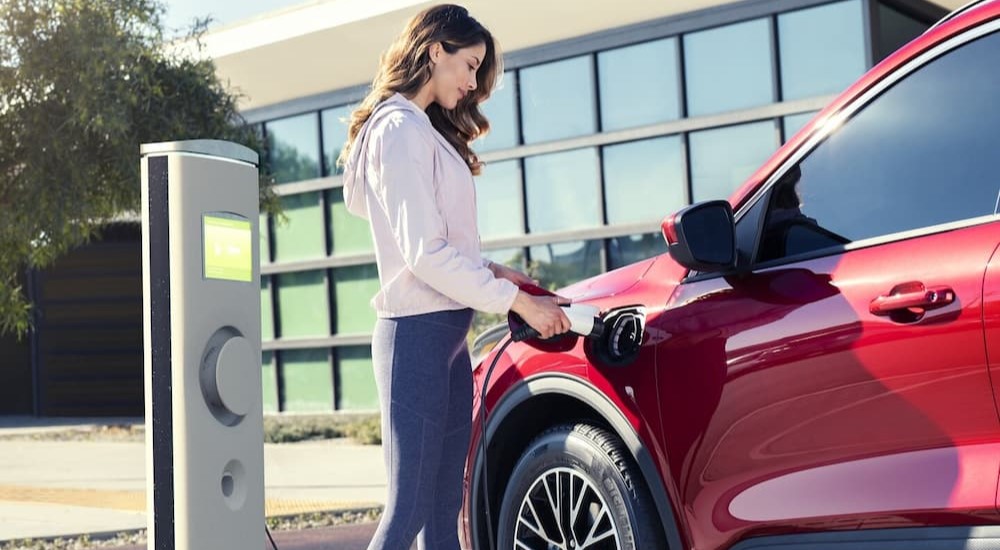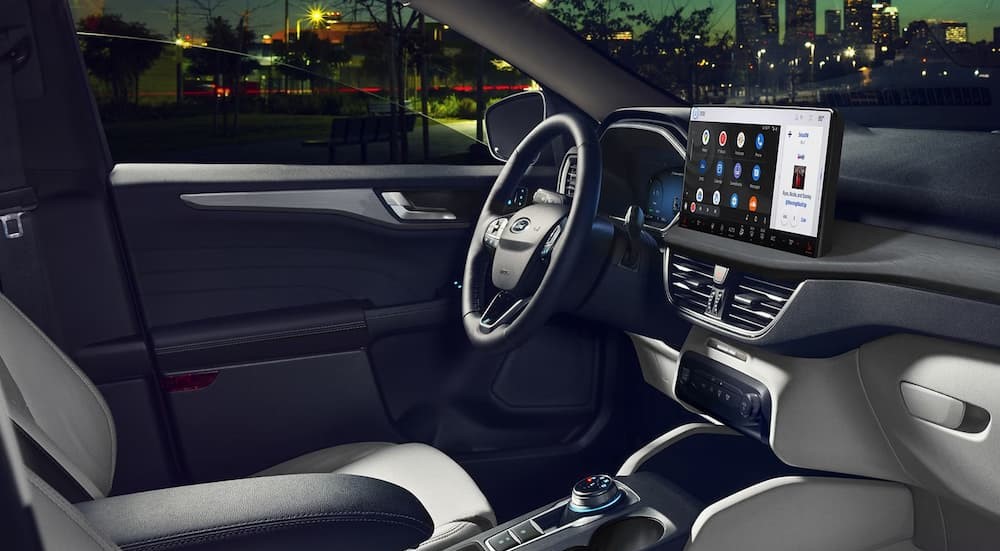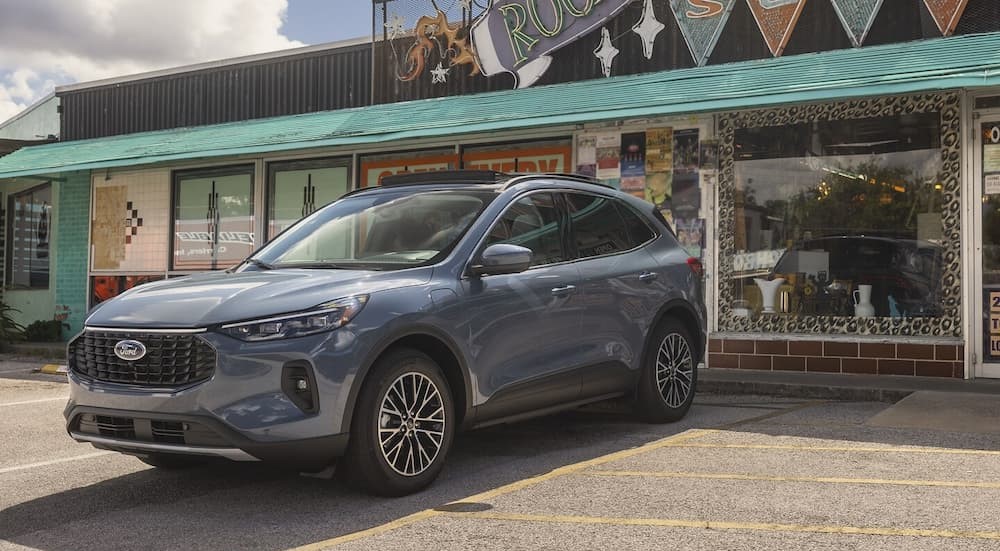In the auto industry today, there is a vigorous push to build a greener, more sustainable future. Automakers like Ford continue to expand their lineups with new models, but they’re also taking the models we know and love and introducing hybrid, plug-in hybrid, and electric variants. The Ford Escape for sale at Blue Oval dealers across the nation is a prime example of this approach and showcases how Ford gives drivers the option to choose the experience they want in the driver’s seat.
The Escape, which has been a staple in the Ford lineup since the new millennium, is a compact crossover praised for its efficiency and engaging driving demeanor. How does that translate with a hybrid and plug-in hybrid powertrain? How can you determine the right powertrain for your driving needs?
Hybrid Power: The 2025 Escape Hybrid
Think of car engines on a spectrum, with traditional gas powertrains on one end and all-electric ones on the other. Hybrid powertrains are a step beyond gas powertrains because they combine what we know—a gas engine—with newfangled electric power. The 2025 Escape Hybrid relies on a 2.5L iVCT Atkinson-cycle inline-four hybrid engine and a small motor and battery that depends on the engine to recharge.
The Escape’s 2.5L engine produces 163 hp and 155 lb-ft of torque, but the additional output from the motor increases the Escape Hybrid’s total output to 192 hp. The battery’s efforts to reduce the demands on the engine make the Escape Hybrid more efficient than its traditional gas-powered sibling. Whether in front- or all-wheel drive, this compact hybrid averages 42 MPG in the city and 36 MPG on the highway.
The Battery’s Impact: Maximizing Efficiency
With a hybrid like the Escape, the gas-powered engine still does most of the work. However, as you see from the Escape Hybrid’s average fuel economy, the small motor and battery pack a mighty punch and increase the SUV’s efficiency. So, how can you maximize this efficiency in the driver’s seat?
Hybrid powertrains typically rely on the battery for power in low-speed conditions. The battery is small, meaning it can’t provide or store a lot of energy. Because of this, the Escape Hybrid is often more efficient when driving in town. In these instances, you can maximize efficiency by going easy on the accelerator, avoiding hard braking, and keeping the Escape in EV or Eco mode to prioritize battery power.
Recharging Needs: At Home? On the Go?
Ford capitalizes on the Escape’s engaging driving demeanor and efficiency without requiring you to veer from what you already know—gas power. The Escape Hybrid’s battery is small enough that the engine can recharge it as you drive, specifically through regenerative braking. A traditional gas-powered vehicle expends a lot of energy when the brakes are engaged; with the Escape Hybrid, regenerative braking captures that energy and uses it to replenish the battery.
So, what does this mean for the hybrid powertrain? Although regenerative braking recharges the battery, the Escape Hybrid primarily relies on fuel. Because of this, there’s no learning curve with the refueling process; the Escape Hybrid has a gas tank just like a traditional gas-powered vehicle. The caveat is that the hybrid engine consumes less fuel, meaning your stops at the gas station will likely be far fewer.
Plug-In Hybrid Power: The 2025 Escape PHEV
The 2025 Escape PHEV is the next step toward building a greener, all-electric future in the driver’s seat. Why? Like its hybrid sibling, a plug-in hybrid like the Escape PHEV combines what you know—a gas engine—with newfangled electric power. So, how does that make it any different than a hybrid? The PHEV has a larger battery, meaning it works harder and does more to reduce the demands on the gas engine.
The 2025 Escape PHEV is powered by a 2.5L iVCT Atkinson-cycle inline-four engine that produces 163 hp and 155 lb-ft of torque. The motor and larger 14.4-kWh battery increase the Escape PHEV’s output to 210 hp and make the 155 lb-ft of torque near-instantaneous for exceptional off-the-line acceleration and responsiveness. This combo makes the Escape PHEV more engaging to drive without compromising its efficiency.
The Battery’s Impact: Maximizing Efficiency
The Escape PHEV has a larger battery, which means it can share most of the demands on the engine. As a result, the Escape PHEV can prioritize battery power at any speed, whether you’re in town or cruising on the highway. However, there are ways to strategically maximize the Escape PHEV’s efficiency and get the most from its 101 MPGe.
MPGe tells us how far a plug-in hybrid vehicle can travel based on a metric we already understand, with MPGe combining gas and electric ranges. For the 2025 Escape PHEV, the SUV can travel approximately 101 miles per gallon. Maximizing that range and increasing the Escape PHEV’s efficiency sometimes means adjusting your driving style. How so?
The Escape PHEV’s battery is larger, but hard acceleration and braking still take a toll on that power. Gradually accelerating and lightly braking is ideal, with the latter engaging the regenerative braking system that can turn unused energy into electricity to recharge the battery as you drive. Likewise, you can engage EV mode to rely solely on the battery or switch to Eco mode to balance the SUV’s reliance on fuel and electricity.
Recognizing the demands placed on the engine by the environment and the accessories running in the background can also proactively help you maximize efficiency. For example, PHEVs use more energy when the weather is colder. Electric efficiency can diminish when you start running the heater or air conditioner at high speeds. The solution is to keep the PHEV plugged in and start the engine to bring the cabin to the ideal temperature before you unplug and set off for your destination.
Recharging Needs: At Home? On the Go?
The 2025 Escape PHEV puts drivers one step closer to an all-electric lifestyle. While electric vehicles rely solely on electric power and must be recharged, the Escape PHEV requires fuel and electricity. Because of this, you’ll need to charge the Escape PHEV’s battery using a 120-volt outlet at home and stop for fuel when the tank is empty.
Initially, plugging in a hybrid might feel intimidating, but Ford makes it simple. You can use a standard 120-volt wall outlet in your garage to recharge the battery, never having to worry about installing a Level 2 or 240-volt charging station. Alternatively, if you don’t feel like plugging in the Escape PHEV’s battery one evening, the SUV will continue running on fuel and operating like a traditional hybrid.
Hybrid or PHEV: Which Escape Is Right for You?
How do you determine which Escape is right for you? Consider your expectations in the driver’s seat, your driving style, where you spend most of your time on the road, and the responsibilities you want as a vehicle owner.
Both models rely on gas power, meaning stopping at gas stations is still required, but the Escape Hybrid can mean fewer stops if you maximize the SUV’s efficiency and spend most of your time in town. Alternatively, the Escape PHEV can truly improve your driving experience by delivering more on-demand power because of its larger battery. You can rely on the Escape PHEV’s EV mode and prioritize electric power over fuel at any speed; the only caveat is that you’re responsible for refilling with fuel and recharging the battery at home—a feat made convenient with the Escape PHEV’s compatibility with a standard wall outlet.






